15 Fruits & Veggies That Are at Peak Deliciousness Right Now
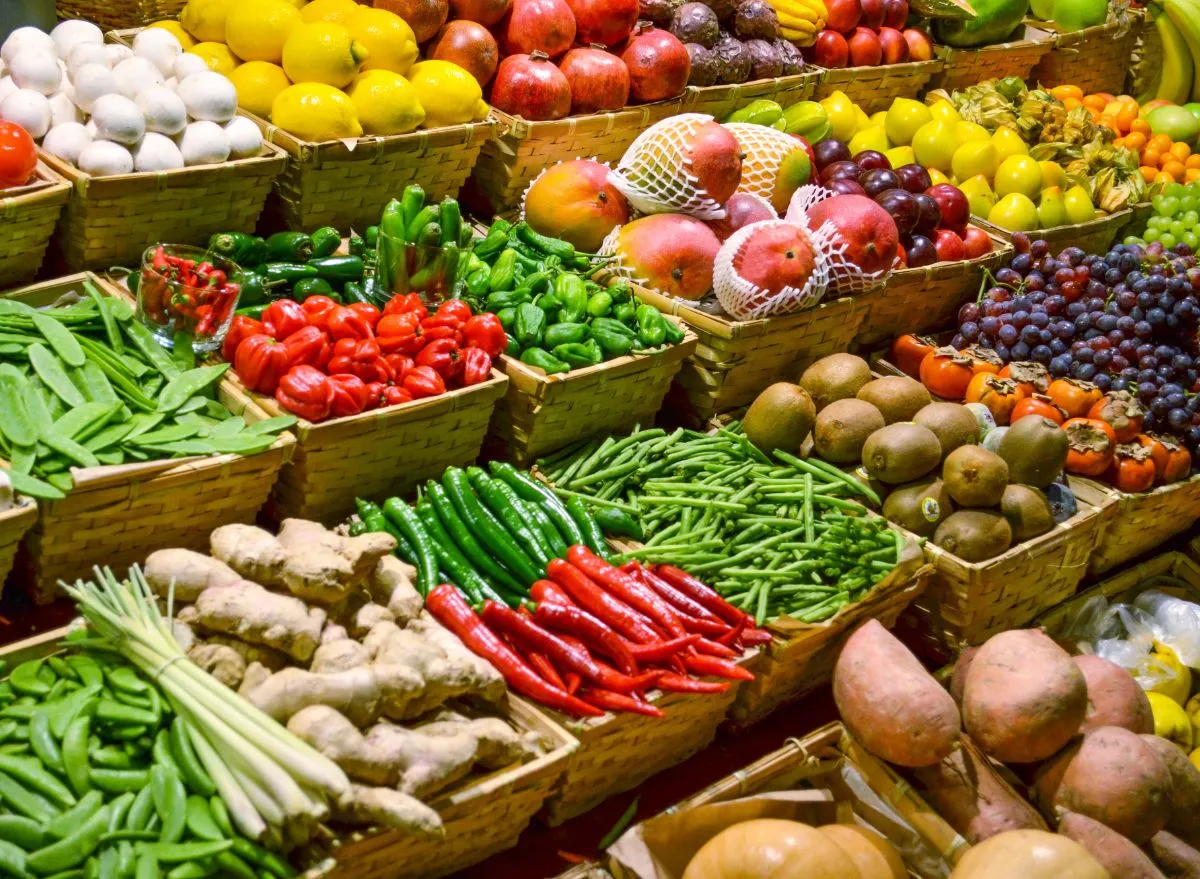
While springtime has now officially arrived, many Americans are still on the cusp of sunshine, blooming buds, and delightful weather that lasts more than a day. Midwesterners and those on the East Coast know all about this tricky in-between time. But soon, people will be shimmying out of their cocoons to embark on grand adventures. One activity that should be on your spring bucket list is purchasing some wonderfully fresh in-season produce. This is the best time of year to catch a wide array of fruits and vegetables at their peak of taste and nutrition while also paying less than usual.
Farmers markets are buzzing and grocery stores are filling up with these recently harvested spring gems. To get an expert opinion on the freshest of the fresh, Eat This, Not That! consulted with produce experts, including a representative from the largest farmer’s market organization in the Mid-Atlantic, Freshfarm, to help identify the best fresh produce that peaks in the spring as the temperature and weather continue to turn.
Read on to discover 15 delicious fruits and veggies to grab right now—and then hit the grocery store.
Asparagus
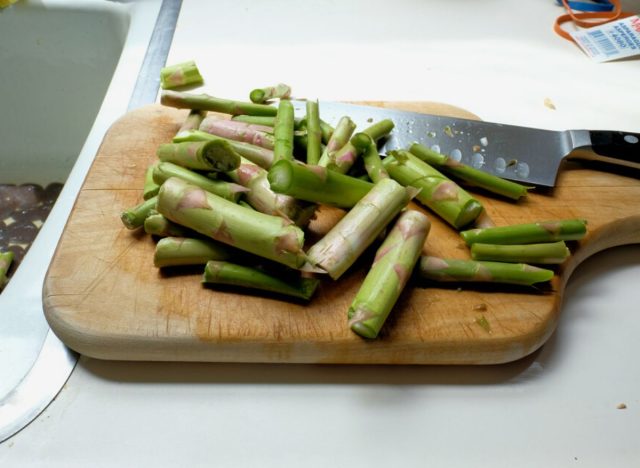
“In spring, we’re shopping at the farmers market for all things green!” says Molly Scalise, director of communications at Freshfarm. All sorts of green veggies are sprouting up now, from leafy to non-leafy varieties. But, one of the best to pick up is asparagus spears, which Scalise calls one of the “hallmarks of spring.”
Asparagus is one of the first in-season produce items to hit shelves following the bitter winter months, ushering in a brand-new season of freshness and flavor. As such, you should stalk the grocery store from late March to June to find the tastiest and least expensive bunches of the year. Cook up asparagus as a healthful side dish, or get crafty in the coming months with recipes like creamy asparagus soup or pasta sprinkled with asparagus tips.
Strawberries
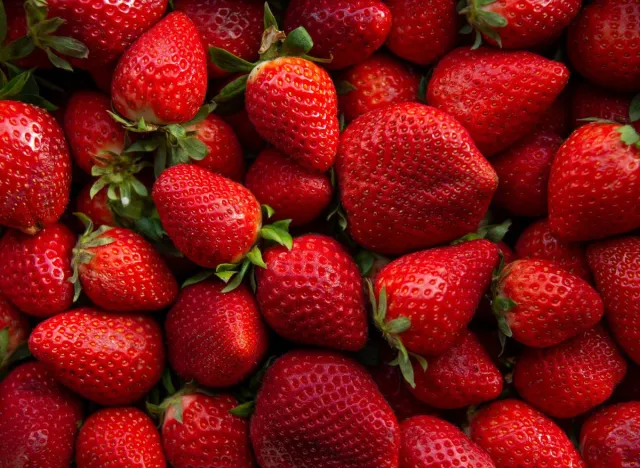
Strawberries are a fruity symbol of spring, reminding us of sunnier days and longer nights. They step into peak freshness around May or even earlier in April for those states farther south. This is the story for strawberries every year. Still, Casey Arnold, a technical services specialist with the biotechnology company Verdant Technologies, explains that U.S. consumers may be in for an even greater harvest in 2024 thanks to the recent rainy weather in California.
“After years of drought conditions putting a strain on California agriculture, weather patterns have brought much-needed moisture to the region,” Arnold says. “While you may have heard a lot about too much rain in California in 2023, one of the positive effects has been replenishing the soil, creating the perfect conditions for a bumper strawberry crop this spring. The nutrients from recent floods, full reservoirs, and ample groundwater mean consumers can expect lots of fresh, juicy strawberries to hit their grocery shelves in the coming weeks.”
The grocery store is certainly a reliable place to find these seasonal berries. But, Scalise with Freshfarm also emphasizes the unmatched favor of local strawberries just harvested at the farm. “Because they’re grown for their taste instead of a long shelf life so they can be transported thousands of miles, local strawberries have a much deeper color and flavor that can’t be beat,” she says.
Lettuce, Spinach, Kale & Collard Greens
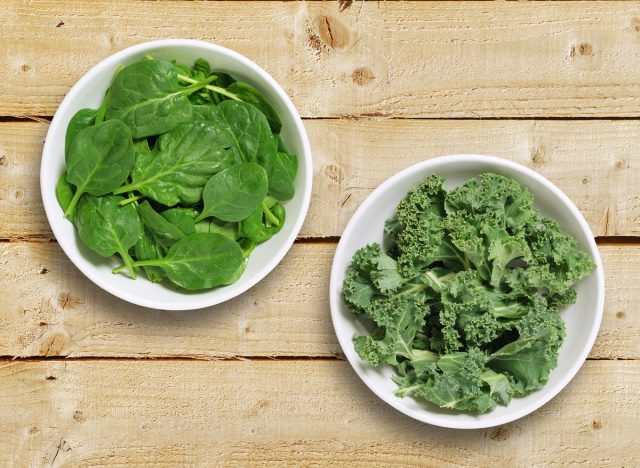
When it comes to in-season produce, leafy greens, including lettuce, spinach, kale, and collard greens, deserve a place in your basket this spring. In this period of change and growth, these vegetables reach their full potential, offering even more nutrients like fiber, vitamins, and minerals than normal.
With roots in the South, collard greens emerge most flavorful when touched by frost in late winter or early spring. Kale, primarily grown in states including California, Georgia, New Jersey, and Texas, thrives in the same environment.
Lettuce and spinach are two greens you can count on your local grocery to carry year-round, so your diet never has to suffer. Both are known to grow best in the cool seasons of spring and fall when temperatures are above 45 degrees and below 70 degrees Fahrenheit.
Cherries
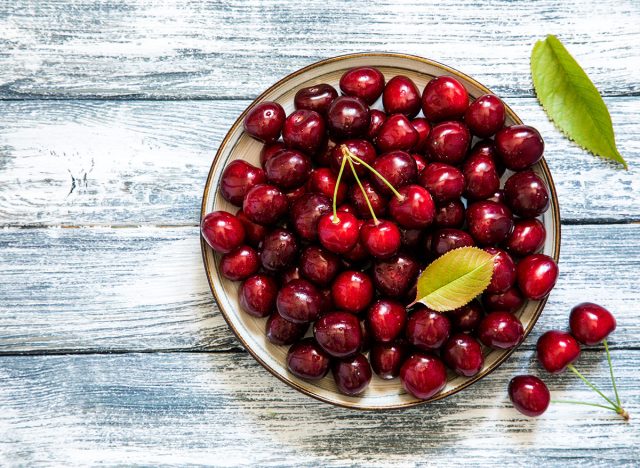
A fresh cherry pie in springtime–can you think of anything more divine? “This seasonal fruit comes back to produce departments in May, as California starts harvesting sweet cherries,” says Brianna Shales, marketing director at Stemilt, one of the nation’s leading suppliers of cherries and other tree fruits. Oregon and Washington contribute to the sweet cherry production at this time, too. Then, later into spring and summer, Michigan is responsible for harvesting about 75% of the tart cherry crop.
It sounds like you have the go-ahead to cherry-pick this spring—whether at an orchard, farmers market, or the grocery store. But be sure to eat them quickly. The red-pitted fruits are known for being highly perishable and last about a week in the fridge.
Snap Peas
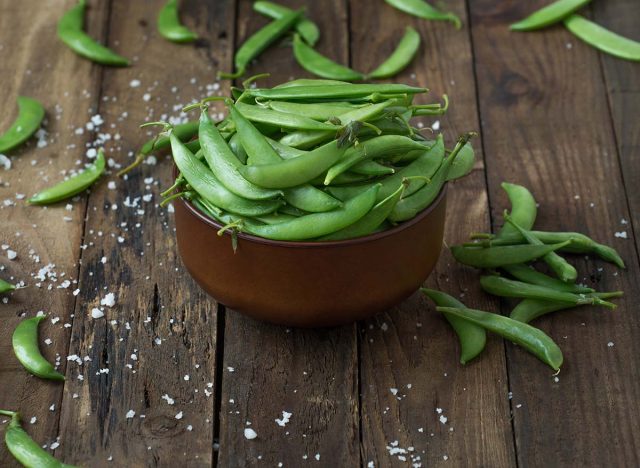
From late spring to early summer, these uniquely sweet veggies start to snap into focus. Snap peas, also known as sugar snap peas, can be identified by their plump pods and crunchy texture. These components make them the perfect add-in for stir-fries or to munch on raw while picnicking in the park or enjoying a day at the beach.
Snap peas land between snow peas—which are much flatter—and standard garden or green peas. The latter also happens to be garden-fresh this time of year, showing off more robust flavor than what you’ll find in frozen or canned varieties.
Mushrooms
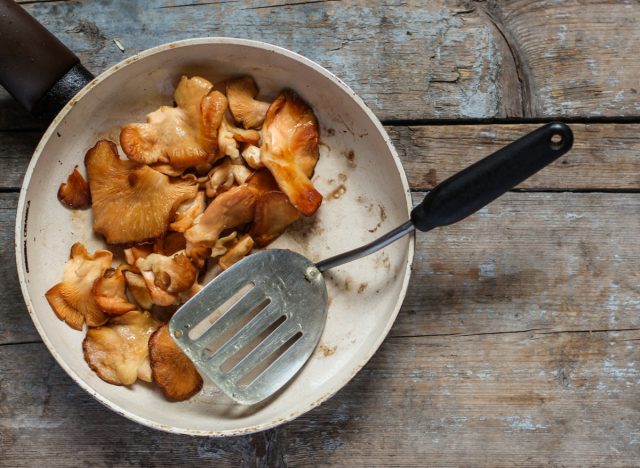
Certain mushroom species pop up from their soil sanctuaries around late April—dependent on the weather factors—ready to be tossed in a hearty pasta dish or paired with poultry in a saucy chicken Marsala. You’ll want to search the market for one type in particular: morels. Says Scalise, “Earthy morel mushrooms are blink-and-you’ll-miss-them foraged delicacies with a very short season that market shoppers go crazy for.” If you’re wondering what on earth a morel mushroom is, you can identify them by their porous and cone-shaped exterior, resembling something like a sponge or honeycombed reef found at the bottom of the ocean.
Other in-season mushrooms you can hunt for at the farmers market in spring include porcini, oyster, and wood ear mushrooms, often used in Asian-style cooking.
Lemons and Limes
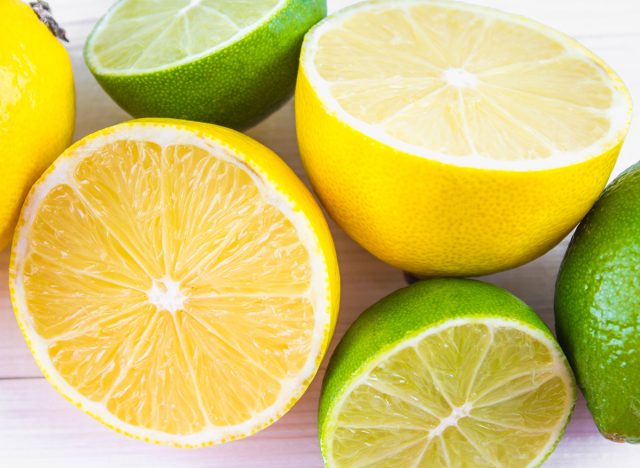
Citrus? For spring? That’s pretty groundbreaking. Since citrusy fruits such as lemons are grown in temperate climates—in the U.S. this means states like Arizona, California, and Florida—many varieties reach their pinnacle of delectability in late fall and throughout winter. But, their seasons dribble over into the early days of spring. Juicy and sweet Meyer lemons are a specific breed to watch for, as they stick around until around April.
Conversely, limes strut their best stuff, starting around May and during hot summer days—just in time to make a classic margarita on Cinco de Mayo or a zesty Key lime pie.
Although these are when lemons and limes are at their finest, both are also known for being available year-round. So, you’ll never have to go without something to zest, squeeze, or juice.
Fresh Herbs and Garlic
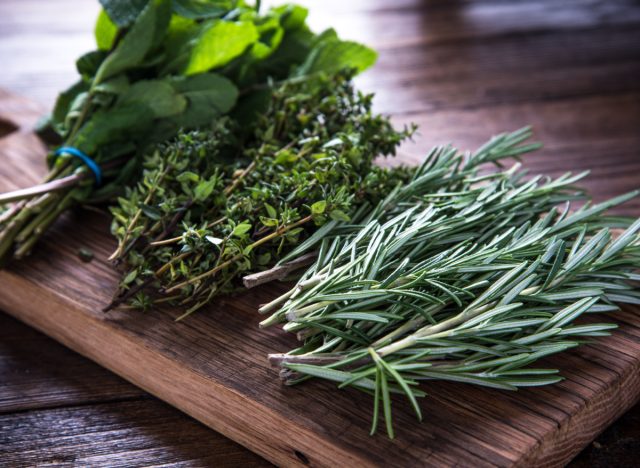
Spring is always in full bloom and full flavor thanks to the burgeoning of fresh herbs. These plants are known for being small yet mighty, with the power to change the essence of an entire dish or meal completely. Since they grow best in warmer weather and with plenty of sunshine, spring and summer are when you should look for basil, rosemary, sage, mint, chives, and dill.
Garlic is another flavor-bomb food accompaniment that is freshly harvested in spring. While shopping for your standard cloves, you may also want to check out the anomaly known as green garlic or spring garlic. In a technical sense, this is just immature garlic that didn’t happen to grow properly. It looks similar to a large scallion with a small bulb on the end, and its less pungent taste makes it great for cooking.
Pineapple
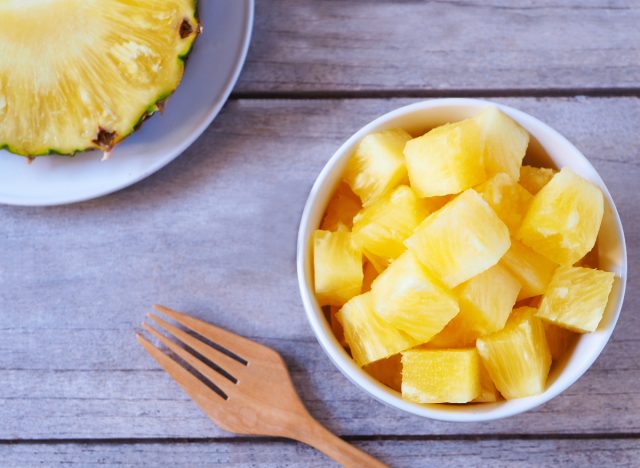
While states like Florida and California have tried their hand at the business, most of the country’s pineapple supply continues to come from Hawaii, with supplemental imports from places like the Philippines, Costa Rica, and Puerto Rico. No matter where they hail from, pineapples always tend to be the sweetest and juiciest from around March to July.
Though perfectly delicious all on its own, you can also bake it into a pineapple upside-down cake, blend it into a smoothie, or mix a sweet pineapple salsa. If you want to go the savory, more-filling route, you could also opt for pineapple chicken tacos or a pineapple-topped pizza—one of the nation’s most controversial foods.
Rhubarb
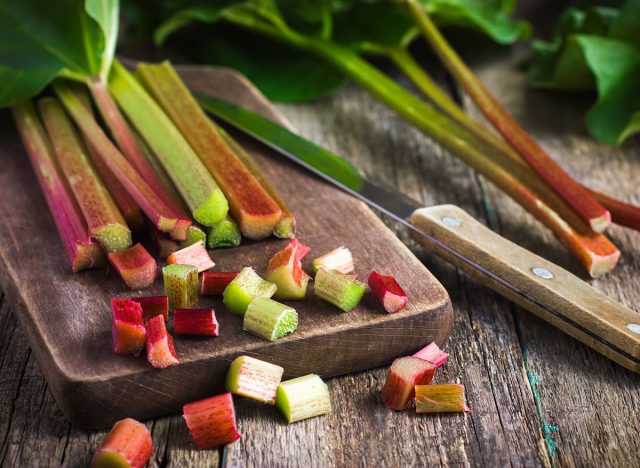
Like asparagus, sour and tangy rhubarb is a vegetable that crops up at the dawn of spring. As such, it’s an ingredient commonly used in Easter or Passover dishes. And, more often than not, you’ll see it teamed up with some fruit to create a balanced dessert. “Fresh rhubarb is gorgeous and perfect to pair with sweet and juicy strawberries in baked goods,” Scalise says.
Strawberry rhubarb pie is the most well-known marriage of these two spring superstars. The dynamic duo meets face-to-face in treats like jam, shortcakes, scones, pancakes, sorbets, and even margaritas.
When picking out your rhubarb, reach for stalks standing firm and tall and sporting a red tone. These tend to offer more sweetness, so they remain tart but aren’t quite as pucker-inducing. Conversely, anything limp, wilting, or covered in blemishes should be left on the shelf as it’s likely past its prime.









